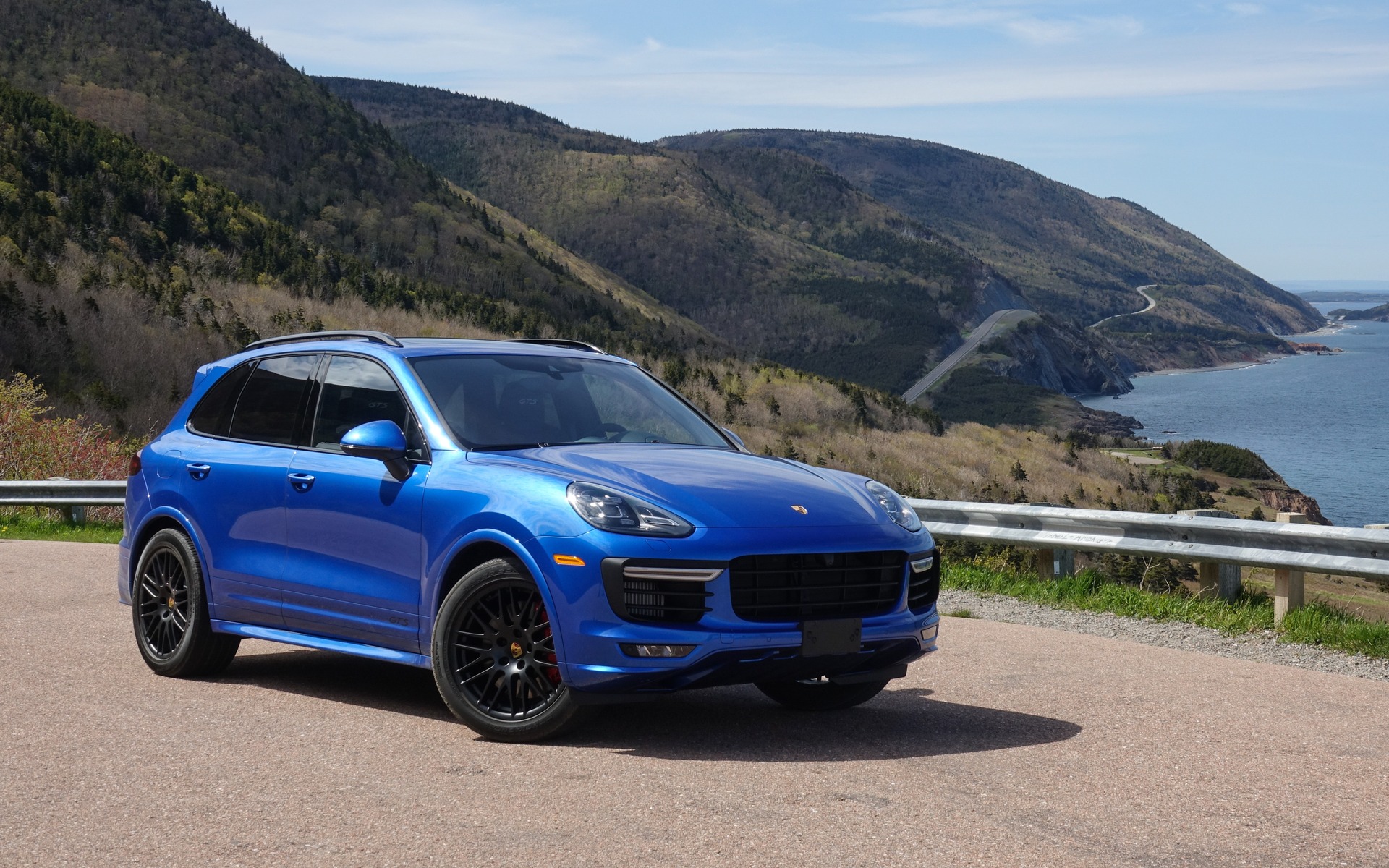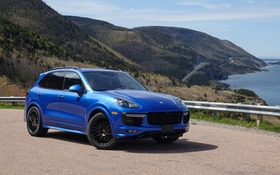Porsche Cayenne GTS and Macan Turbo on the Cabot Trail

| Strong points |
|
|---|---|
| Weak points |
|
CHÉTICAMP, Cape Breton Island – You simply can’t refuse an opportunity to drive a Porsche, especially when someone else is paying for gas and even when it’s one of the brand’s two sport utility vehicles. And even when they aren’t new models. The second-generation Cayenne is already in its seventh year and its compact little brother, the Macan, is turning three.
It’s not as though Porsche needs help selling its SUVs. Since the first Cayenne was launched in 2003, the Zuffenausen-based manufacturer has more than quadrupled its sales and tripled the number of model lines it builds. More than 70% of Porsches currently produced are Cayennes and Macans and, just last month, their combined sales were up more than 25% while those of the Macan alone were up 56%.
- Also: Off-roading in a Porsche Cayenne: Even my Grandmother Could do it!
- Also: Voluntary recall for Porsche Macan models
Truly sporty utility vehicles and a road of dreams
Typically, SUVs aren’t very sporty at all. However, since the Cayenne and Macan are the most agile SUVs out there, we couldn’t wait for this trip. Right from day one, the Cayenne was proof that Porsche’s engineers could achieve good performance and solid handling even from a high-sitting vehicle weighing more than two tonnes.
The primary goal of this one-day-only road trip was to travel the wonderful Cabot Trail, a asphalt ribbon that traces the jagged Cape Breton coast for nearly three hundred kilometres, like well-cooked spaghetti, with all its turns, climbs, descents and spectacular views of the Atlantic on one side and the Gulf of the St. Lawrence on the other.
To get there, we first had to drive from Halifax Airport to Inverness, where the Cabot Trail begins. It’s over three hundred kilometres on secondary roads that quickly become interesting beyond Nova Scotia’s capital.
Once outside the terminal, there were five Porsches patiently waiting for us: three Cayenne GTSs and two Macan Turbos. The Cayennes were painted in three distinctive colours (sapphire blue, meteor grey and carmine red) and, while they featured different options, they had identical engines. All were equipped with the twin-turbo, 3.6-litre V6 that produces 440 horsepower and 443 lb.-ft. of torque. With an eight-speed automatic gearbox, the GTS reaches 100 km/h in 5.1 seconds (yes, we measured it).

Classic method for an exceptional car
There was more than the paint job that distinguished the two Macan Turbos from one another. The first’s engine was also a twin-turbo, 3.6-litre V6, but generating 400 horsepower and 406 lb.-ft. of torque for a 0-100 km/h time of 4.9 seconds (also measured). The faster time is because the Macan Turbo is 185 kilos lighter than the Cayenne GTS.
The second Macan Turbo was equipped with the new Performance Package that gives it the same 3.6-litre V6 as the Cayenne GTS, but with 434 horsepower. Like the other Macan, it comes with the superb seven-speed, twin-clutch PDK gearbox that shifts instantly and downshifts in a snap using the levers behind the steering wheel. There’s no reason to doubt the manufacturer’s claim of a 4.4-second 0-100 km/h time in Sport Plus mode.
I christened it “The Hot Rod.”
The Performance Macan’s front brakes were also fitted with the same 390-mm discs as the Cayenne GTS instead of the standard 360-mm rotors. It’s 15 mm lower than its big brother for added agility. As luck would have it, I was able to verify this right way because I got to drive The Hot Rod first. With 265/40 performance tires mounted on 21-inch rims like the Cayenne, it was glued to the road and the steering was precise and clean.
Its coarse and melodious sound in flat-out acceleration confirmed that it was the most enjoyable of the quintet. Press the sport exhaust button or activate Sport Plus mode to make the suspension firmer, sharpen the accelerator and tighten the shifting up even more. Do that, however, and you’ll have to live with much higher speeds for each gear. Save it for tighter sections of the road or for driving on a track.

The tough laws of physics
The contrast is very stark when going from the super Macan Turbo to the first Cayenne. Although the GTS has always been considered the athlete of the model line for its handling, its 24-mm lower body and the inclusion of the adjustable Porsche Active Suspension Management (PASM), it feels much higher and more ungainly than its kid brother. Indeed, it is nearly 70 mm higher, just about 31 mm wider and heavier, to boot. Its reactions are less lively and its steering is less precise, even though it is fitted with wider and lower size 295/35 tires mounted on the optional 21-inch “three-season” tires.
The next day’s test drive of a second Cayenne GTS fitted with performance tires proved that they make the steering more precise, more responsive and more poised in turns. The price to pay is a stiffer ride. Note that all Cayennes and Macans are firm to varying degrees, but their solid body, well-dampened suspension and carefully sculpted seats make it tolerable—if you value control and thrills as much as comfort, that is.
If you want your Cayenne GTS with the Porsche Dynamic Chassis Control (PDCC) system, which adds power roll bars that reduce roll to almost nothing, be prepared to fork out an extra $4,010. There’s also the $1,700 PTV Plus (Porsche Torque Vectoring Plus) system that transfers torque to the outside wheels to improve handling in turns. Carbon ceramic disc brakes (PCCB) can be added for $10,090 if it strikes your fancy to take it out on a race track.
Oh, did I mention that our five Cayennes and Macans were already rather expensive? Well, the suggested as-tested price of the Macan Turbo is $108,390 and $110,300 for the Performance version. The as-tested prices for our three Cayenne GTS vehicles are $125,498, $131,900 and $134,855, respectively. Preparation included, before taxes.
If you take all the available and imaginable options, your Macan Turbo with Performance Package can increase to $178,545 and the Cayenne GTS to $196,252, before taxes. Buying a Porsche is like choosing items à la carte at a gourmet restaurant or having a suit tailor-made. It’ll cost you, but you can build a perfectly unique Porsche SUV, even though there are thousands on the road.

Porsche-style comfort and control
On the Cabot Trail, our Cayenne GTSs and Macan Turbos proved very quiet. Word to the wise: on spectacular roads where the speed limits drop suddenly as you approach a village or national park, you may not realize how fast you’re actually driving. The driving position and comfort of the seats are irreproachable.
In both, visibility in their central rearview is limited due to the modestly sized window and three headrests blocking much of the view. Obviously, the Macan’s trunk is a little smaller than the Cayenne’s (500 litres versus 670 with the rear seatback in place) but you can easily transport two small suitcases and two backpacks. The message is clear. The Cayenne GTS can tow up to 2865 kg, and the Macan Turbo, up to 2400 kg.
Buttons and controls still abound inside. For example, there are twenty-four different buttons on the Macan Turbo’s central console, four switches and six climate controls. Not to mention the button for the hazard lights. The Cayenne GTS has twelve system buttons, including the adjustable suspension and the four-wheel drive, and nearly twenty for climate control and the like.
That’s often better than searching for settings throughout menus that are not always clear or logical on the (relatively) small touch screen located in the middle of the dashboard.
In any event, the important thing to know is that all versions of the Cayenne and Macan, even the most affordable, are endowed with the sport capabilities that make a Porsche a Porsche, even when it’s a truck—or a sort of truck. It’s just that the degree of sportiness depends on the tastes and budget—or lack thereof—of the buyer. It’s as simple as that.











